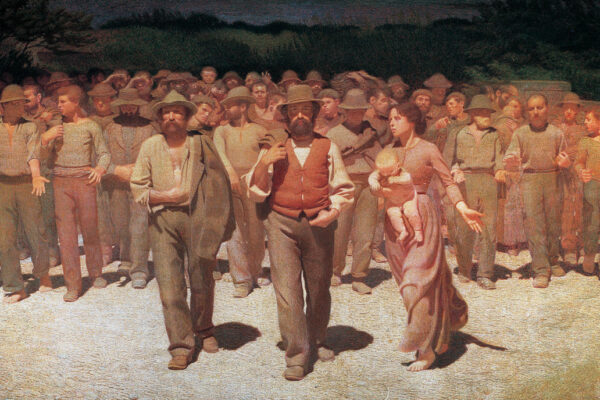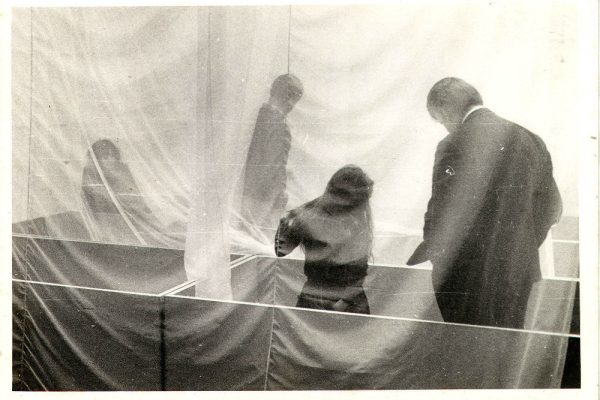Primo Levi: the Man and the Narrator
In a passage of the Confessions, probably the most influent modern autobiography, Jean-Jacques Rousseau reflects on Michel de Montaigne, asserting with a certain malice that “Montaigne offers us a likeness, but in profile. Who knows if some scar on the cheek or a missing eye on the side he keeps hidden from us would not totally have changed his physiognomy?”1 Rousseau claims here a seminal point: the fictionality of the person who says “I” in the autobiographical narration. But he has a further aim, which is to highlight the truthfulness of the protagonist of his autobiography, the Confessions: the real Jean Jacques Rousseau. In one of his interviews, Primo Levi claimed about his own style as a writer: “I am not always sure that a writer knows, rather, that he recognizes his own style. It is something like when you see your own image in a mirror: you can only see the face and never the profile.”2 Levi’s conclusion seems quite at odds with Rousseau’s. Yet at a closer glance, this opposition-Rousseau trying to assure the reader about the truthfulness of his character, Levi skeptically asserting its impossibility-is not only meaningful but, in the case of Levi, painful.
 Primo Levi is a key figure in the testimony of the Holocaust, and a seminal author for the interpretation of 20th-century history and civilization. Without writing a proper autobiography, Levi’s writing as a whole sprouts like a literary response to the events of his biography. Consequently, a thorough understanding and interpretation of his work and his life needs to take into account and describe not only the witness of the Holocaust, but the writer who narrated the stories of a whole life, his own, even beyond the Nazi camp experience. Yet in order to achieve this goal, one must begin from his most original literary invention: the invention of himself as a narrator, born in Survival in Auschwitz 3 without literary or premeditated origin.
Primo Levi is a key figure in the testimony of the Holocaust, and a seminal author for the interpretation of 20th-century history and civilization. Without writing a proper autobiography, Levi’s writing as a whole sprouts like a literary response to the events of his biography. Consequently, a thorough understanding and interpretation of his work and his life needs to take into account and describe not only the witness of the Holocaust, but the writer who narrated the stories of a whole life, his own, even beyond the Nazi camp experience. Yet in order to achieve this goal, one must begin from his most original literary invention: the invention of himself as a narrator, born in Survival in Auschwitz 3 without literary or premeditated origin.
This figure was born as the witness of the extermination camps: Levi the witness of Auschwitz, his very person narrated, is the untold word clearly perceptible in all of his writings. Levi’s voice represents itself in this appearance not only in the works about the camps but also in his fantastic stories and science fiction. The moral meditations of the author as well as his powers of observation belong to the “I” character in Survival in Auschwitz. In fact, they draw their authority from the utterance of the first book, belonging to the witness of the unheard. Yet it is a kind of narration that will need new and specific justifications for further developments. Levi adopts these justifications by aligning himself with different literary traditions and by finding his antecedents within it. Referring to his first book, in an interview Levi claimed: “I’ve constructed a sort of legend around that book, that I wrote without a plan, that I wrote it on impulse, that I wrote it without reflecting at all. The other people I’ve talked to about it accepted the legend. In fact, writing is never spontaneous. Now that I think about it, I can see that this book is full of literature, literature absorbed through the skin, even while I was rejecting it.” 4
In actuality, the tutelary figures of Levi’s storytelling are two. Both of them are narrators that recount to an incredulous audience facts personally seen and experienced. The first is the Homeric Ulysses who, after resting in the court of the King of the Phaeacians, finds pleasure after the ordeal through telling his experiences to an astonished audience. Nevertheless, if the Homeric Ulysses is an archetypal figure, the same cannot be claimed about the second reference, although a tragic shadow associates them. Like the messengers who reach Job in the Bible, both of the figures might introduce themselves saying that “I am the only one who survived to tell this story,” as Levi himself writes. In his work there is a quotation so recurrent as to turn into obsession: it is from the “Rime of the Ancient Mariner,” by Samuel Taylor Coleridge. The old protagonist of Coleridge’s “Rime” is cursed for his whole life, compelled to torment strangers by telling them the “ghastly tale” he survived. Between the pleasure and the curse of storytelling, between the Homeric Ulysses and the Coleridgean Ancient Mariner lies the narrow space in which Primo Levi works. Without interruption, Levi is always looking for a sort of archaeology of his own storytelling; moreover, this tension has to be framed in distancing through a literary boundary the overwhelming experience of the concentration camp from himself.
In a lecture delivered in the 1970s, Levi defined himself, paraphrasing Isaac Deutscher, as a “writer who is not a writer,” a formula that links his profession as a chemist to the particular autobiographical writing of The Periodic Table. 5 This seminal lecture clearly binds his two main activities: chemistry and writing. Levi sees in the experience of the chemist “a long symbolic shadow . . . also like a primitive hunter. In the evening when he draws the formula for the molecular structure he will have to build tomorrow, he carries out the same propitiative rite as the hunter of Altamira who 50,000 years ago drew on the cave walls the elk or the bison he would have to kill the next day: to appropriate it, to make the antagonist his. Both are sacral gestures.” 6
It is another remarkable moment in the development of Levi’s narrator: it condenses all of the different experiences of a lifetime, justifies them through an ethnological legacy, and finally verifies them (or exorcises them) through the literary representation. The space of the tale grows beyond the testimony of the survivor with the witnessing of a whole lifetime, through his own experiences and through those heard from other people or from a third storyteller, as in The Monkey’s Wrench. 7
Yet, after this last book, Levi develops another possibility intrinsic to his “narrated-narrator.” In the subsequent works he turns back to his own identity, coming closer to the Jewish narrative tradition, especially the tradition of Eastern European Judaism. Levi then rediscovers a different modality of storytelling, whose matrix has distant roots in time and space. Thus, in Moments of Reprieve 8, Levi describes the encounter with this world known through the people he met in Auschwitz and their stories. Even if a posteriori, Levi feels he is somehow an heir of this culture: with the adoption of its narrative features he becomes (in Italy) a witness of Eastern European Judaism, to the extent of giving an epic representation of this civilization in the novel If Not Now, When? 9
The story “Lilith,” from Moments of Reprieve, represents the standard of this further development of the narrated-narrator, by means of the tales told to Levi by Tischler the carpenter. Annoyed and amused at the same time, Tischler narrates a number of Jewish legends to the “epicurean” Levi. Why “epicurean”? Because he is a Western European Jew who neither speaks Yiddish nor knows Jewish legends. Tischler then introduces to an attentive Primo the legend of the supposed first wife of Adam, Lilith. At a certain point in the narration, however, he breaks the spell of his uncommon tale and refers directly to his listener, calling him to order: “Why are you laughing? Of course, I don’t believe this, but I like to tell these stories. I liked when they were told to me, and it would be a shame if they were lost. In any case, I won’t guarantee that I myself didn’t add something, and perhaps all who tell them add something: and that’s how stories are born.” 10
“That’s how stories are born,” claims Tischler the carpenter. But Tischler could be a fictive character, an invention of Levi, a go-between of memory and writing, or a juxtaposition of many real people, as often happens in literature. Still, this excerpt contains two opposite truths, even beyond the pleasure and the curse of storytelling. By means of his character, Levi is not only implicitly questioning the importance of historical truthfulness, but also asking for a proper space-the space of his narration-where he may feel free to tell each story in the fittest shape, adding details, freeing himself from the constraints of history. But on the other hand, this hoped-for freedom is morally inadequate for the role he himself pursued throughout his life: the witness of Auschwitz. As Walter Benjamin claims, the authority of the storyteller and its compulsory listening are a shadow of the authority of the dying man revealing in his last words the meaning of his life, his “legacy.”
Levi embodies both of these features. Nevertheless, the legacy of the dying man in the last years must have become for him an unbearable burden, inasmuch as they eroded the private identity of the writer. In his last writings and interviews, Levi’s attempts to redefine himself, to retell the truth about his own person, continuously intensify. The meditation regarding the distance between real life and the literary image sharpens. Levi was forcibly confined by his own experience to attain to a totally pervasive matter and framework. Nevertheless, as noted by the Italian scholar Domenico Scarpa, his works are full of images representing overflows, as it were breaking free from the cocoon. They are ambivalent, frightful figures that once again hint at what is behind the apparent tranquillity of his writing.
This tension is apparent in another tale from Moments of Reprieve, “Tired of Imposture.” 11 The title reveals the obsession with his character’s truthfulness, but the original in Italian (“Stanco di finzioni”) is yet more meaningful. “Finzione” indeed means both “imposture” and “fiction,” linked together in a single word. This obsession reverberates implicitly in the figure of Levi as an author, showcasing his frustration with the literary disguise adopted. “Tired of Imposture” outlines the difficult relationship between the written character and the living person. Levi writes: “Anyone who has the opportunity to compare the true image of a writer with what can be deduced from his writings knows how frequently they do not coincide. . . . But how pleasant and cheering is the opposite case: the man who remains true to himself in what he writes; even if he is not brilliant our sympathy goes immediately to him. Here there no longer are deceit or transfiguration, Muses or quantum leaps. The mask is the face, and the reader seems to be looking from a height at a clear body of water and distinguishing the multicolored pebbles on the bottom.”
Eventually, the ending of the tale casts a new light on this reflection. Levi claims that the protagonist will not write his story: “He is tired, tired of deception and disguises. This is why, in writing as in telling about his extraordinary adventure, he has not tried to deceive, to represent himself as different from what he is and always has been.”
The overwhelming problem of Levi the writer lies again in the tension between the truthfulness of a whole life and its literary representation. Although it finds a somehow steady solution in the texts, this tension reverberates back to the same Levi the person, and shows up again in the writings of the last period. In many passages he is extremely close to defining his literary invention as a mystification. For instance, there is a revealing contrast between the enthusiasm shown in Tischler’s words and the bitterness of Levi’s claims in the disquieting interview he gave, a few months before dying, to the journalist Roberto Di Caro: “For the most part, authors choose one part of themselves, the best part. At times I have portrayed myself in my books as brave, at others as cowardly, prophetic or naïve, but always, I think, as a balanced individual. . . I’m not very balanced at all.” 13
This concern with redefining himself, with scratching away the literary fiction around the self-representation, can be found everywhere in Levi’s last works and interviews, chiefly in order to avoid being associated with the figure of the prophet. The rejection of this figure became indeed almost violent in the above interview with Di Caro, when Levi said: “They are the curse of our time, prophets. Or perhaps the curse of all times.” It could be a sign of the suffering due to the showcasing of his own person, as well as of the role of witness. It could also be a hint of his entry into the “age of the testimony,” as the French historian Annette Wieviorka puts it 13, an age that features, in the most recent decades, the use and abuse of the Holocaust as a “civil religion” of the Western world. Such a conception and a mystification of the Holocaust is utterly at odds with the ethics of Levi’s work of witnessing and with his practice of writing.
Notes
This passage is quoted from the seminal study by Mario Lavagetto, La cicatrice di Montaigne: sulla bugia in letteratura (Turin: Einaudi, 2002), 128. For reference: Jean-Jacques Rousseau, Confessiones, ed. Patrick Coleman, trans. Angela Scholar (Oxford University Press, 2000).
Primo Levi, “Conversazione con Santo Strati e Franco Pappalardo La Rosa,” in Marco Belpoliti (ed.), Riga 13 (1997): 84. The translation is mine.
Levi, Survival in Auschwitz: The Nazi Assault on Humanity, trans. Stuart Woolf (New York: Simon & Schuster, 1995).
Levi, “Germaine Greer Talks to Primo Levi,” in The Voice of Memory: Interviews 1961-1987, ed.
Marco Belpoliti and Robert S. C. Gordon, trans. Robert S. C. Gordon (New York: New Press, 2001), 3.
Levi, The Periodic Table, trans. Raymond Rosenthal (New York: Schocken Books, 1984).
Levi, “The Writer Who Is Not a Writer,” in The Black Hole of Auschwitz, trans. Sharon Wood (Cambridge: Polity Press, 2005), 105.
Levi, If Not Now, When?, trans. William Weaver (New York: Summit Books, 1985).
Levi, The Monkey’s Wrench, trans. Ruth Feldman and William Weaver (New York: Summit Books 1986).
Levi, “Lilith,” in Moments of Reprieve, 42.
Scarpa, Domenico, “Chiaro/oscuro,” in Riga 13, 230-53.
Levi, “Tired of Imposture,” in Moments of Reprieve, 127-35.
Levi, “The Essential and the Superfluous,” in The Voice of Memory, 173.
Wieviorka, Annette. The Era of the Witness (Ithaca: Cornell University Press, 2006).









